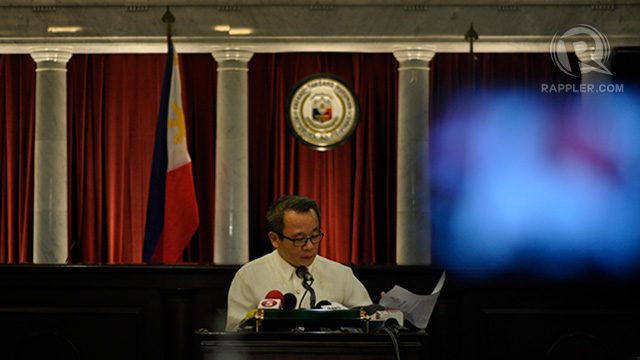SUMMARY
This is AI generated summarization, which may have errors. For context, always refer to the full article.

MANILA, Philippines – Should Supreme Court (SC) press briefings be covered by the ban on live coverage of its court proceedings?
“It’s not a rule of the SC. It’s part of how this PIO understands its role,” SC Public Information Office (PIO) chief Theodore Te said in a text message, when asked why he did not permit the live coverage of a 2 pm SC press briefing on Tuesday, June 3.
While there is no ban per se on airing SC press conferences live, Te said “permission is sought from PIO when networks want to bring in cables to go live.”
He added that it is part of his job to regulate “the Court’s messaging requirements which include how a press con is to be conducted within the Court’s premises as far as facilities are concerned.”
Journos condemn PIO take
In separate statements issued Wednesday, June 4, both the Justice Reporters Organization (JUROR) and the Justice and Court Reporters Association (JUCRA) condemned what appeared to them as a new policy instituted by the SC PIO.
Reporters from both organizations who were present during the briefing noted how they were told by an SC PIO staff that the Tuesday press conference would only begin once cables for live TV broadcast were pulled out from the cameras.
Many reporters lamented what they deemed to be a newly-communicated policy, saying it is part of the job of the SC PIO to make information about the Court’s decisions accessible.
JUROR President Teresa Tavares called it “a big step backward in advancing good governance,” while JUCRA’s founding member Rey Panaligan said “the SC should be the example of transparency.”
“It would be worthy to emphasize that the media has the responsibility to inform the public of what is happening in the Highest court of the land and the fastest way is to air live the press conferences,” Tavares added.
Dialogue sought
As news broke on media reactions to the PIO’s policy, Te sought a dialogue with reporters covering affairs in the High Court.
Te pointed out that he had disallowed live coverage of a news conference only once since he took over as SC spokesman in January 2013.
“Yesterday, however, I did say no simply because in my estimation the stories that would come out wouldn’t be that newsworthy,” he said, explaining his decision about the Tuesday briefing.
Among the SC decisions announced during the briefing were: a temporary restraining order on a tax regulation requiring doctors to disclose their service fees, the dismissal of a petition seeking the nullification of former Senator Panfilo “Ping” Lacson’s post as rehabilitation czar, and an order for the government to comment on consolidated petitions seeking to void a controversial military pact between the Philippines and the United States.
Te admitted that it was “unwise” for him to have determined on his own which court decisions were newsworthy.
“Perhaps that may have been an unwise presumption on my part that I was worthy of appreciating the newsworthiness of the stories that would be reported but did it constitute intent to violate press freedom and prevent transparency? I think that is a stretch considering that it is one incident in almost two years,” he added.
Te also said he would have changed his mind had one of the reporters asked for a reconsideration. “No one from JUCRA or JUROR bothered to ask me to reconsider whether we could go live despite my having said ‘no’, they just went ahead and disregarded what I had said and set it up,” he said.
Never in PIO’s history
Reporters have yet to agree to a dialogue with the SC PIO chief, noting that it was the first time such a system was enforced.
“Since 1998, when the PIO was created, we were allowed to air live press briefings. The PIO staff would even assist us to set up our cables and equipment. Why the sudden change now? May we also remind Atty Te that we are only airing live news conferences and NOT court proceedings,” Tavares said.
Panaligan, who has covered the SC for over 4 decades, said he “could not recall an incident, before the creation of its public information office, when the SC declined live television or radio coverage of an announcement of a resolution or decision, particularly those that affect public interest.”
The long-time court reporter added that the announcement of a promulgated decision must not be treated in the same manner as “closed-door deliberation of cases.”
“The SC should be the example of transparency. It should not only, as it does, uphold press freedom in its decisions. It should practice it,” he added. – Rappler.com
Add a comment
How does this make you feel?
There are no comments yet. Add your comment to start the conversation.